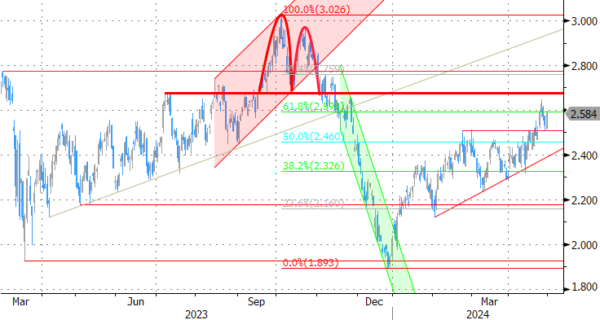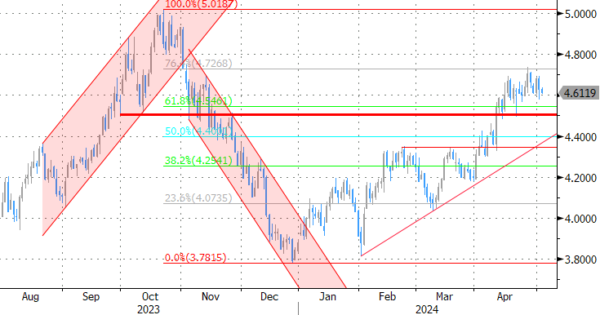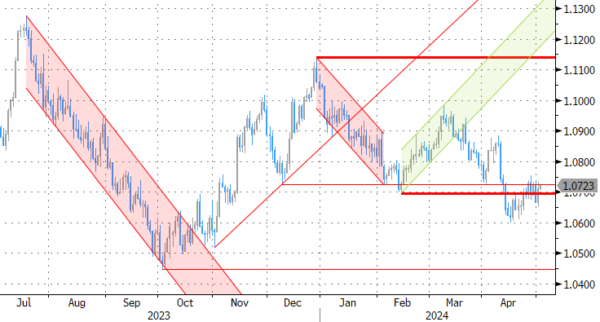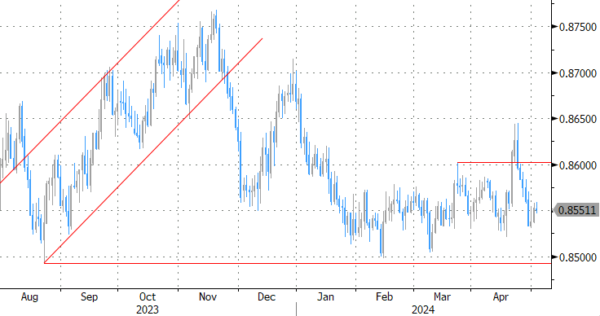Markets
The Fed kept the policy rate stable at the 5.25%-5.50% range yesterday. The statement did feature some changes, including that “In recent months, there has been a lack of further progress toward the Committee’s 2 percent inflation objective.” It also announced that the Fed will reduce the pace of QT in Treasuries from $60bn to $25bn while keeping the $35bn cap in MBS. The “lack of further progress” translated in chair Powell saying it’s going to take longer to gain the confidence that inflation is indeed back on track towards target. In terms of policy rates, it boils down in keeping them at the current level for a little while longer. That’s exactly what markets have been repricing for in recent months. Some in the outskirts of the market even began contemplating about rate hikes again. Powell noted it was unlikely that the next move would be an increase. Minutes later he did say that “In terms of peak rate, […] I think the data will have to answer that question for us.” Turning to those data, yesterday’s was a mixed bag. The April ADP job report (192k with an upward revision to March) was stronger than expected. But the manufacturing ISM unexpectedly dipped in contraction territory again (49.2) while price pressures in the sector intensified sharply. Yields finished the session lower in technically irrelevant trading. Daily changes varied between -3.5 bps (30y) to -7.5 bps (2y). The dollar lost ground against the euro (EUR/USD 1.0712) though we should add that this happened in holiday-thinned European trading (Labor Day). It was also partially a spillover from what is a presumed FX intervention by Japanese officials in late US dealings. USD/JPY dropped sharply from 158 to an intraday low of 153.04 before closing at 154.57. US stock markets swung from gains of up to 1.75% (Nasdaq) in volatile trading.
The Japanese yen is once again in the spotlights during Asian dealings, erasing about half of yesterday’s gains and confirming that FX interventions do not change a currency’s fundamental course. Stocks in the broad region trade mixed with few news stories to guide them. The dollar and euro trade balanced while yields in the US ease less than 2 bps. The economic calendar contains the (outdated) Q1 productivity numbers and unit labor costs. The jobless claims give us the usual weekly look on the labour market. All in all we don’t think it’ll trigger big swings ahead of tomorrow’s US services ISM and the payrolls report. We may see German bonds outperform in core markets as they catch up with the US yesterday but we wouldn’t draw any firm conclusions from that. Technical trading could keep EUR/USD oscillating around the 1.07 big figure as it has been doing for the last couple of sessions.
News & Views
The US Treasury released its quarterly refunding statement yesterday. Since August 2023, Treasury has significantly increased issuance sizes for nominal coupon and FRN securities. Based on current projected borrowing needs, Treasury does not anticipate needing to increase them further for at least the next several quarters. Actual auction sizes remain steady for the May-July period at their April (peak) level of $69bn, $58bn, $70bn and $44bn for 2-yr, 3-yr, 5-yr and 7-yr sales. The longer tenors follow the same rhythm as in the Fed-Apr period implying higher auction sizes in the first month (cumulative $83bn for 10-yr, 20-yr & 30-yr in May vs $74bn in June & July). Treasury expects to increase the 4-, 6-, and 8-week bill auction sizes in the coming days to ensure sufficient liquidity to meet one-week cash needs around the end of May. Over the course of July, auction sizes will reach the highs from February and March. Finally, Treasury announced the launch of a buyback program. They aim to end up with operation sizes of maximum $30bn per quarter across buckers for liquidity support.
Rating agency Moody’s raised the outlook on Brazil’s Ba2 rating from stable to positive. Improved growth prospects with upside potential over the medium and long term are one reason. Moody’s expects growth to average around 2% in coming years. Second, structural reforms over successive administrations support policy effectiveness with institutional guardrails reduce policy uncertainty. Finally, gradual fiscal consolidation may lead to a stabilization of the debt burden. A new fiscal framework limits the increase in real primary spending to 70% of the increase in real revenues in the previous year.
Graphs
GE 10y yield
ECB President Lagarde clearly hinted at a summer (June) rate cut and has broad backing. EMU disinflation will continue in April and bring headline CPI (temporarily) at/below the 2% target. Together with weak growth momentum, this gives backing to deliver a first 25 bps rate cut. A more bumpy inflation path in H2 2024 and the Fed’s higher for longer strategy make follow-up moves difficult. Markets come to terms with that, pushing yields up.
US 10y yield
The Fed in May acknowledged the lack of progress towards the 2% inflation objective. Upcoming CPI readings and a resilient economy/labour market will continue to prevent the Fed to cut rates fast nor deep. September at the earliest, but December is more likely. US yields, especially at the front end, could catch a breather after the recent sharp repricing, but their bottom is well protected.
EUR/USD
Economic divergence (US > EMU) and a likely desynchronized rate cut cycle with the ECB exceptionally taking the lead pulled EUR/USD towards the previous YTD low at 1.0695. Stronger-than-expected US March inflation figures forced a technical break. Last year’s low at 1.0494 looks vulnerable.
EUR/GBP
Debate at the Bank of England is focused at the timing of rate cuts. Most BoE members align with the ECB rather than with Fed view, suggesting that the disinflation process provides a window of opportunity to make policy less restrictive (in the near term). Sterling’s downside turned more vulnerable with the topside of the sideways EUR/GBP 0.8493 – 0.8768 trading range serving as the first real technical reference.

















